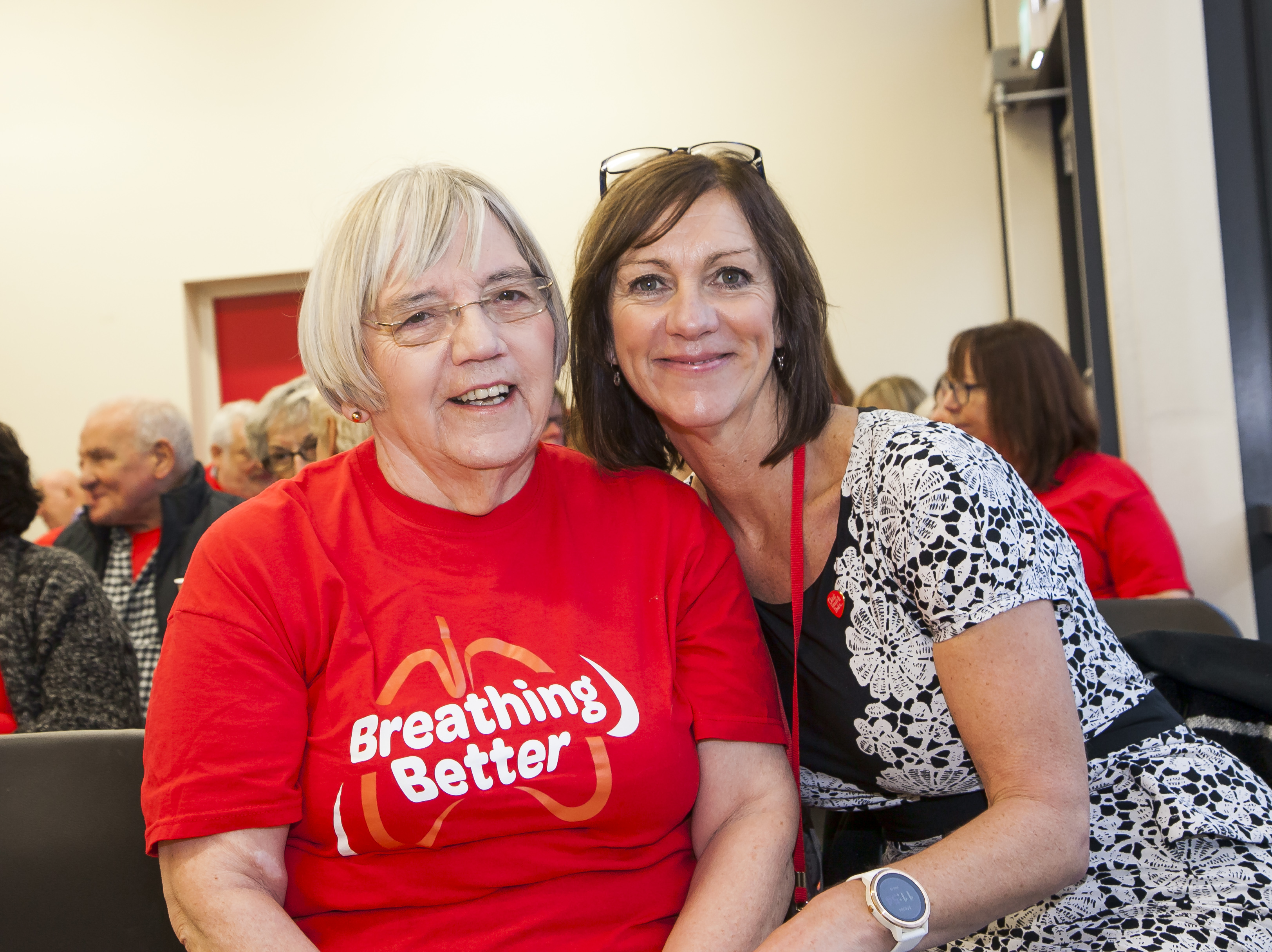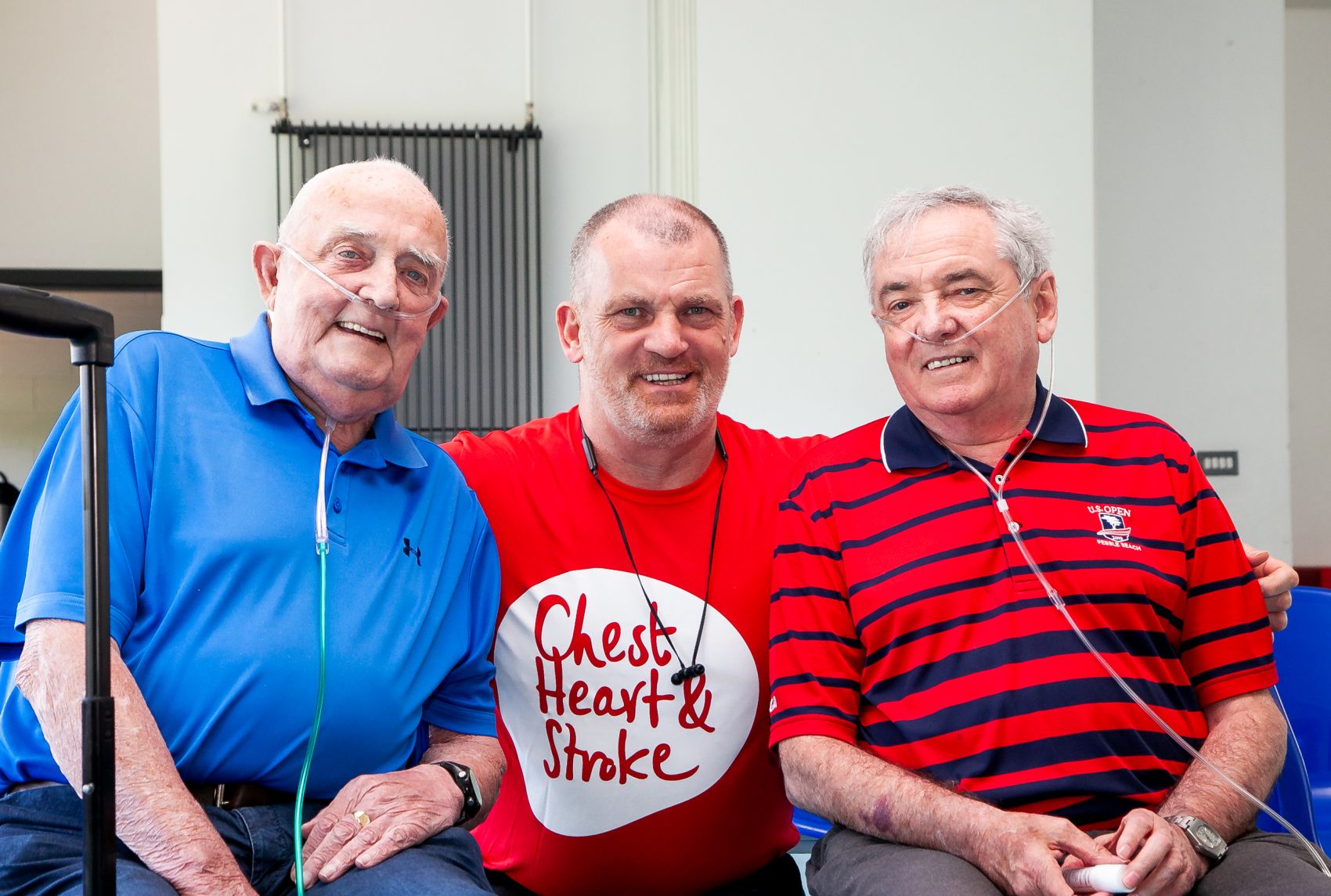A “chest” or respiratory condition is not always obvious to other people – it is often referred to as an ‘invisible illness.’ People do not always realise the impact respiratory conditions can have on a person’s life and the lives of their families and carers. This means they don’t always receive the necessary support and understanding, and their health may get worse.
If you are affected by a chest condition, knowledge, skills and the right services will make a real difference to your health and well-being. Our experienced and compassionate Breathing Better team is here to help.

I want to tell people that no matter how bad your breathing condition may appear to you, taking the right advice can give you a new lease of life.
-
In order to survive your body needs oxygen from the air you breathe. The lungs are designed to absorb oxygen from the air and transfer it into the bloodstream and then to remove waste gases, such as carbon dioxide.
When you breathe air in, through your nose or mouth, it travels down the back of your throat (pharynx), passes through your voice box (larynx), and into your windpipe (trachea). Your trachea is divided into two air passages (bronchial tubes). One bronchial tube leads to the left lung, the other to the right lung.
The respiratory system has built–in methods to prevent harmful substances from entering your lungs:
- Your nose moistens and warms the air.
- The hair (cilia) in your nose helps filter out large particles.
- Mucus produced by cells in the trachea and bronchial tubes keeps air passages moist and helps in trapping dust, bacteria, and other substances.
- Cilia hair in the air passages moves in a sweeping motion upwards towards the throat and mouth to get the mucus and bacteria etc out of the lungs.
- Healthy lungs are made of a spongy, pinkish–greyish tissue. Lungs that have become polluted with harmful particles, like smoke, appear to have blackened spots on the surface. Healthy lungs are elastic so they can expand when you breathe in. In contrast, a disease such as emphysema causes the lungs to lose their elasticity. When a lung can no longer expand properly or transfer oxygen to the blood, the person has difficulty breathing and tires easily. Other difficulties can occur because the tissues and organs aren’t getting the oxygen they need.
-
Asbestosis is a type of scarring of the lung caused by prolonged exposure to asbestos fibres. Asbestos was used in the past in building construction to protect against fire and as a form of insulation. It develops in some people who have breathed in a substantial amount of asbestos dust in the course of their work.
Symptoms include shortness of breath and a cough, and may not appear for twenty or thirty years after exposure.
More information can be found at: http://www.nhs.uk/conditions/asbestosis
-
Asthma is a condition that constricts the airways – the small tubes that carry into and out of the lungs. People with asthma have sensitive airways which react to triggers. When an asthma sufferer comes into contact with one or more of these triggers, the muscles around the walls of the airways tighten and they become narrower, making it harder to breathe. The lining of the airways also becomes inflamed and begins to swell.
Asthma symptoms include breathlessness, wheezing, tight chest or a persistent cough – often at night, early in the morning or during/after activity.
More information can be found at :
http://www.nhs.uk/conditions/asthma

"Having asthma really does have an effect on what you can and cannot do. I don’t get asthma attacks, but I suffer from breathlessness. "
-
Normally the airways get smaller as they go further into the lungs, like the branches of a tree. Bronchiectasis is a permanent abnormal widening in one or more of them. Extra mucus tends to form and pool in these wider airways, making the body prone to infection. The cause is often not clear, but some conditions that affect or damage airways can trigger bronchiectasis.
Almost all causes of bronchiectasis make your airways less able to clear mucus and more prone to infection. Bronchiectasis creates a vicious cycle; infections damage your airways, and when your airways are damaged you get more infections.
The main symptoms of bronchiectasis are:
- A persistent cough
- Producing a lot of green–yellow phlegm which can be thick and very sticky
- Breathlessness and wheezing
- Recurring chest infections
- Feeling tired and unwell
- Loss of appetite which could result in weight loss
- A persistent infection of the nasal sinuses that lasts for weeks or months
- A constant runny nose (catarrh)
More information can be found at: http://www.nhs.uk/Conditions/Bronchiectasis

"I found it hard to breathe and my skin was grey. Now my consultant calls me the Miracle Man! I've had a new lease of life."
-
What Causes COPD?
COPD (Chronic Obstructive Pulmonary Disease) is an umbrella term for a group of lung conditions that cause permanent damage to a person’s airways. It is usually associated with long-term exposure to irritants. In the majority of cases, smoking is the cause. However, occupational or environmental factors, such as dust or chemicals, and some inherited problems can also cause COPD. COPD tends to creep up on people. They can cope with it for many years before symptoms reach a point that that forces them to see a doctor. Symptoms can include:
- A persistent cough
- Wheezing
- Production of mucus or phlegm
- Shortness of breath
- Chest infections
COPD Triggers
Although COPD cannot be cured, its symptoms can be treated and your quality of life can be improved. Some things can irritate your lungs and make your COPD symptoms worse. For example, air pollution, smog, second–hand smoke, strong fumes, perfume and scented products, cold air or hot and humid air.
Ways to avoid COPD triggers:
- Use unscented cleaning products
- Avoid wearing perfume or aftershaves
- Avoid using aerosol sprays
- Turn on the kitchen fan when cooking
- Avoid smoke either from surrounding smokers or fireplaces
- Stay indoors on days which have high air pollen or pollution counts
- When you are outside in cold weather, breathe through a scarf that covers your nose and mouth
- Avoid people who have the cold or flu
- Get your annual flu vaccination
- If you smoke, STOP
If you have COPD and you continue to smoke, more damage will be done and your symptoms will get worse. If you stop smoking, this will help improve your cough and mucus and slow the rate at which you become breathless. It is not easy to stop smoking but help is available.
Have a look at our Give Up Smoking advice and ask your GP for information on nicotine replacement products. Many local hospitals run smoking cessation clinics and there are some GPs who also provide this service. More information can be found on the Stop Smoking NI page.
For more information download our COPD booklet.
Paddy's Story
-
Cancer develops when cells become abnormal and grow out of control. Over time they form a clump known as a tumour. Cancer that begins in the lungs is known as primary lung cancer. Cancer that begins in another part of the body before spreading to the lungs is known as secondary lung cancer. There are two main types of primary lung cancer: small cell (SCLC) and non–small cell (NSCLC). About 1 in 5 cases are small cell. These cancers tend to be more aggressive and are commonly caused by smoking.
The two main types are treated quite differently. Chemotherapy and radiotherapy are usually used for small cell lung cancer. Surgery, chemotherapy and radiotherapy can all be used for non–small cell lung cancer.
More information can be found at: http://www.nhs.uk/Conditions/Cancer-of-the-lung
-
Obstructive sleep apnoea is a condition that causes interrupted breathing during sleep. In deep sleep, the muscles of the throat relax. Normally this doesn’t cause any problems. In obstructive sleep apnoea, however, complete relaxation of the throat muscles causes blockage of the upper airway at the back of the tongue. At first, this causes snoring. If there is a complete blockage then breathing actually stops (apnoea) for around 10 seconds. Your blood oxygen level goes down and your brain tells you to wake up. After you start breathing properly, you will normally go back to sleep quickly and will not even be aware that you have woken.
This often becomes a continuous cycle and can happen hundreds of times each night. The result is that you feel tired during the day and lack concentration.
More information can be found at :
-
Pneumonia is an infection of the lungs. Many different germs can cause pneumonia, including bacteria, viruses, and fungi. If you are normally healthy, this usually doesn’t matter, because they are trapped in mucus and are killed by the immune system. Sometimes, however, the germs multiply deep in the lungs, overcome your body’s normal defences and cause lung infections.
Pneumonia can affect people of any age, although it is more common and can be more serious in babies, young children, elderly, people who smoke or have other health conditions (respiratory or a weaker immune system).
More information can be found at :
-
Pulmonary fibrosis means scarring (thickening) of the tissue of the lung. Scarring is part of the body’s repair process and can help to heal injured areas. However, scar tissue can stop the lungs doing their job effectively. Not enough oxygen is passed into the blood, leading to breathing difficulties brought on by simple activities such as walking and talking. Pulmonary fibrosis may be associated with a separate underlying disease, such as rheumatoid arthritis. When there is no known cause for its development, it is termed ‘idiopathic’.
The most common symptom of idiopathic pulmonary fibrosis is breathlessness, which can get worse over time. Less common symptoms are a dry cough and a change in the shape of your fingernails and toenails.
More information can be found at:
-
Tuberculosis (often called TB) is a disease caused by a germ called mycobacterium tuberculosis. It spreads by the inhalation of tiny droplets from the coughs or sneezes of an infected person. TB mainly affects the lungs. However, the infection can spread to many parts of the body, including the bones and nervous system.The bacteria responsible for TB are very slow moving, so TB develops slowly in the body.
You may not experience any symptoms for many months or even years after being infected. Typical symptoms of TB include – a persistent cough, weight loss and night sweats.
More information can be found at:
-
Sarcoidosis is an inflammatory autoimmune disease. The inflammation produces small lumps of cells, known as granulomas, in certain organs. One of the common areas for sarcoidosis to attack is the lungs. Sarcoidosis of this kind is often referred to as Pulmonary Sarcoidosis.
Symptoms include dry coughing, breathlessness, wheezing, tiredness and fatigue as well as discomfort and upper back pain.
When sarcoidosis involves the lungs, it may be recognised by your doctor from a chest x–ray. A biopsy of the lungs may be needed to confirm the diagnosis.
Sarcoidosis can occur at any age but is most frequent in young adults. It is rare that children get sarcoidosis.
The cause or causes of sarcoidosis are unknown. Since only a minority of people with sarcoidosis require specific treatment, it is common for doctors to observe your symptoms and test results for a few months in case your sarcoidosis becomes inactive on its own. Steroids are an effective way of suppressing sarcoidosis and for many people will be the only treatment needed.
More information can be found at:
Download our Chest Conditions Factsheets:
-
Chest Conditions FactsheetDownload pdf
-
Asthma FactsheetDownload pdf
Please note that the information on this website is not a substitute for the advice your doctors or other health care professionals may give you based on their knowledge of your condition.

